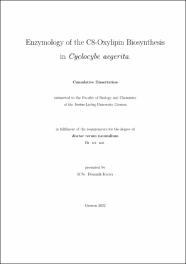| dc.description.abstract | Based on transcriptomic, volatilomic and metabolomic data of the model organism Cyclocybe aegerita, the endogenous and enzymatic production of the C8-oxylipins oct-2-en-1-ol, octan-1-ol, oct-2-enal, octanal, octan-3-ol, oct-1-en-3-ol, oct-1-en-3-one and octan-3-one via biotransformations with [U-13C]linoleic acid was compared to the developmental state depending gene expression patterns of putative oxylipin-associated enzyme classes like lipoxygenases, dioxygenases, ene-reductases and alcohol dehydrogenases. On closer consideration of these data sets, the C8-oxylipin production seemed to occur cluster-like.
While one cluster (ketonic-cycle) consisted of octan-3-ol, oct-1-en-3-one, octan-3-one and oct-1-en-3-ol, which were detected through out all developmental stages, a second cluster (aldehydic-cycle) primarily active at early developmental stages involved oct-2-enal, octanal, oct-2-en-1-ol and octan-1-ol. Studying these clusters revealed that all C8-oxylipins of the aldehydic-cycle and ketonic-cycle can be derived from oct-2-enal and oct-1-en-3-one, respectively. A detailled consideration of the gene expression patterns revealed several enzyme classes putatively involved in the C8-oxylipin biosynthesis. Especially the two genes AAE3 04864 and AAE3 13549 encoding the lox4- and enr1-gene showed great similarities between their strongly increasing transcript counts with maturation. Subsequent recombinant production of CaeLOX4 and CaeEnR1 revealed that CaeLOX4 showed a preference for C18-fatty acids with the highest affinity towards linoleic acid. Analysis of the reaction product revealed that this LOX selectively oxygenated linoleic acid at position 13 to 13-hydroperoxyoctadecadienoic acid (13-HPOD). CaeEnR1 showed high affinities towards the reduction of oct-1-en-3-one and oct-2-enal to their saturated counterparts octan-3-one and octanal, respectively. Due to the strong similarities between the expression patterns of CaeLOX4 and CaeEnR1 a coherence between their main reaction products 13-HPOD and the precursor of the ketonic-cycle oct-1-en-3-one seems very likely. This suggests a biosynthetic route from linoleic acid to 13-HPOD, followed by a subsequent cleavage step to oct-1-en-3-one and therefore to C8-oxylipins of the ketonic-cycle. | de_DE |



